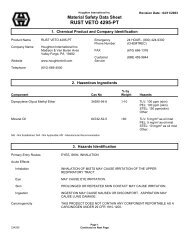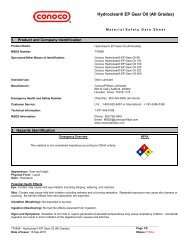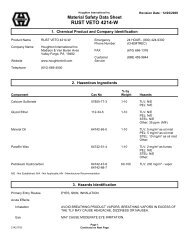Synterra® Hydraulic Fluid (All Grades)
Conoco-Synterra-Hydr..
Conoco-Synterra-Hydr..
You also want an ePaper? Increase the reach of your titles
YUMPU automatically turns print PDFs into web optimized ePapers that Google loves.
<strong>Synterra®</strong> <strong>Hydraulic</strong> <strong>Fluid</strong> (<strong>All</strong> <strong>Grades</strong>)<br />
M a t e r i a l S a f e t y D a t a S h e e t<br />
1. Product and Company Identification<br />
Product Name:<br />
<strong>Synterra®</strong> <strong>Hydraulic</strong> <strong>Fluid</strong> (<strong>All</strong> <strong>Grades</strong>)<br />
MSDS Number: 778864<br />
Synonyms: <strong>Synterra®</strong> <strong>Hydraulic</strong> <strong>Fluid</strong> 32<br />
<strong>Synterra®</strong> <strong>Hydraulic</strong> <strong>Fluid</strong> 46<br />
<strong>Synterra®</strong> <strong>Hydraulic</strong> <strong>Fluid</strong> 68<br />
Intended Use:<br />
Manufacturer:<br />
Emergency Health and Safety Number:<br />
<strong>Hydraulic</strong> <strong>Fluid</strong><br />
ConocoPhillips Lubricants<br />
600 N. Dairy Ashford, 2W900<br />
Houston, Texas 77079-1175<br />
Chemtrec: 800-424-9300 (24 Hours)<br />
Customer Service: U.S.: 800-822-6457 or International: +1-83-2486-3363<br />
Technical Information: 800-766-0050<br />
MSDS Information: Phone: 800-762-0942<br />
Email: MSDS@conocophillips.com<br />
Internet: http://w3.conocophillips.com/NetMSDS/<br />
2. Hazards Identification<br />
Emergency Overview<br />
NFPA<br />
This material is not considered hazardous according to OSHA criteria.<br />
Appearance: Clear and bright<br />
Physical Form: Liquid<br />
Odor: Petroleum<br />
Potential Health Effects<br />
Eye: Contact may cause mild eye irritation including stinging, watering, and redness.<br />
Skin: Contact may cause mild skin irritation including redness and a burning sensation. No harmful effects from skin absorption are<br />
expected.<br />
Inhalation (Breathing): Not expected to be toxic.<br />
Ingestion (Swallowing): No harmful effects expected from ingestion.<br />
Signs and Symptoms: Inhalation of oil mists or vapors generated at elevated temperatures may cause respiratory irritation. Accidental<br />
ingestion can result in minor irritation of the digestive tract, nausea and diarrhea.<br />
See Section 11 for additional Toxicity Information.<br />
________________________________________________________________________________________________<br />
778864 - <strong>Synterra®</strong> <strong>Hydraulic</strong> <strong>Fluid</strong> (<strong>All</strong> <strong>Grades</strong>) Page 1/6<br />
Date of Issue: 16-Nov-2009<br />
Status: Final
778864 - <strong>Synterra®</strong> <strong>Hydraulic</strong> <strong>Fluid</strong> (<strong>All</strong> <strong>Grades</strong>)<br />
Date of Issue: 16-Nov-2009<br />
Page 2/6<br />
Status: Final<br />
________________________________________________________________________________________________<br />
3. Composition / Information on Ingredients<br />
Component CASRN Concentration*<br />
Synthetic Lubricant Base Oil PROPRIETARY >98<br />
Additives PROPRIETARY
778864 - <strong>Synterra®</strong> <strong>Hydraulic</strong> <strong>Fluid</strong> (<strong>All</strong> <strong>Grades</strong>)<br />
Date of Issue: 16-Nov-2009<br />
________________________________________________________________________________________________<br />
6. Accidental Release Measures<br />
Personal Precautions: This material may burn, but will not ignite readily. Keep all sources of ignition away from spill/release. Stay<br />
upwind and away from spill/release. Notify persons down wind of the spill/release, isolate immediate hazard area and keep unauthorized<br />
personnel out. Wear appropriate protective equipment, including respiratory protection, as conditions warrant (see Section 8). See<br />
Sections 2 and 7 for additional information on hazards and precautionary measures.<br />
Environmental Precautions: Stop spill/release if it can be done safely. Prevent spilled material from entering sewers, storm drains,<br />
other unauthorized drainage systems, and natural waterways. Use water sparingly to minimize environmental contamination and<br />
reduce disposal requirements. If spill occurs on water notify appropriate authorities and advise shipping of any hazard. Spills into or<br />
upon navigable waters, the contiguous zone, or adjoining shorelines that cause a sheen or discoloration on the surface of the water,<br />
may require notification of the National Response Center (phone number 800-424-8802).<br />
Methods for Containment and Clean-Up: Notify relevant authorities in accordance with all applicable regulations. Immediate cleanup<br />
of any spill is recommended. Dike far ahead of spill for later recovery or disposal. Absorb spill with inert material such as sand or<br />
vermiculite, and place in suitable container for disposal. If spilled on water remove with appropriate methods (e.g. skimming, booms or<br />
absorbents).<br />
7. Handling and Storage<br />
Precautions for safe handling: Keep away from flames and hot surfaces. Wash thoroughly after handling. Use good personal hygiene<br />
practices and wear appropriate personal protective equipment.<br />
High pressure injection of hydrocarbon fuels, hydraulic oils or greases under the skin may have serious consequences even though no<br />
symptoms or injury may be apparent. This can happen accidentally when using high pressure equipment such as high pressure grease<br />
guns, fuel injection apparatus or from pinhole leaks in tubing of high pressure hydraulic oil equipment.<br />
Do not enter confined spaces such as tanks or pits without following proper entry procedures such as ASTM D-4276 and 29CFR<br />
1910.146. Do not wear contaminated clothing or shoes.<br />
Conditions for safe storage: Keep container(s) tightly closed. Use and store this material in cool, dry, well-ventilated area away from<br />
heat and all sources of ignition. Store only in approved containers. Keep away from any incompatible material (see Section 10). Protect<br />
container(s) against physical damage.<br />
"Empty" containers retain residue and may be dangerous. Do not pressurize, cut, weld, braze, solder, drill, grind, or expose such<br />
containers to heat, flame, sparks, or other sources of ignition. They may explode and cause injury or death. "Empty" drums should be<br />
completely drained, properly bunged, and promptly shipped to the supplier or a drum reconditioner. <strong>All</strong> containers should be disposed<br />
of in an environmentally safe manner and in accordance with governmental regulations. Before working on or in tanks which contain or<br />
have contained this material, refer to OSHA regulations, ANSI Z49.1, and other references pertaining to cleaning, repairing, welding, or<br />
other contemplated operations.<br />
8. Exposure Controls / Personal Protection<br />
Page 3/6<br />
Status: Final<br />
Component US-ACGIH OSHA Other<br />
Synthetic Lubricant Base Oil<br />
5mg/m 3 TWA<br />
10 mg/m 3 STEL<br />
as Oil Mist, if Generated<br />
5 mg/m 3 TWA<br />
as Oil Mist, if Generated<br />
---<br />
Note: State, local or other agencies or advisory groups may have established more stringent limits. Consult an industrial<br />
hygienist or similar professional, or your local agencies, for further information.<br />
Engineering controls: If current ventilation practices are not adequate to maintain airborne concentrations below the established<br />
exposure limits, additional engineering controls may be required.<br />
Eye/Face Protection: The use of eye protection that meets or exceeds ANSI Z.87.1 is recommended to protect against potential eye<br />
contact, irritation, or injury. Depending on conditions of use, a face shield may be necessary.<br />
Skin/Hand Protection: The use of gloves impervious to the specific material handled is advised to prevent skin contact. Users should<br />
check with manufacturers to confirm the breakthrough performance of their products. Suggested protective materials: Nitrile
778864 - <strong>Synterra®</strong> <strong>Hydraulic</strong> <strong>Fluid</strong> (<strong>All</strong> <strong>Grades</strong>)<br />
Page 4/6<br />
Date of Issue: 16-Nov-2009<br />
Status: Final<br />
________________________________________________________________________________________________<br />
Respiratory Protection: Where there is potential for airborne exposure above the exposure limit a NIOSH certified air purifying<br />
respirator equipped with R or P95 filters may be used.<br />
A respiratory protection program that meets or is equivalent to OSHA 29 CFR 1910.134 and ANSI Z88.2 should be followed whenever<br />
workplace conditions warrant a respirator's use. Air purifying respirators provide limited protection and cannot be used in atmospheres<br />
that exceed the maximum use concentration (as directed by regulation or the manufacturer's instructions), in oxygen deficient (less than<br />
19.5 percent oxygen) situations, or under conditions that are immediately dangerous to life and health (IDLH).<br />
Suggestions provided in this section for exposure control and specific types of protective equipment are based on readily<br />
available information. Users should consult with the specific manufacturer to confirm the performance of their protective<br />
equipment. Specific situations may require consultation with industrial hygiene, safety, or engineering professionals.<br />
9. Physical and Chemical Properties<br />
Note: Unless otherwise stated, values are determined at 20°C (68°F) and 760 mm Hg (1 atm). Data represent typical values and are<br />
not intended to be specifications.<br />
Appearance:<br />
Clear and bright<br />
Physical Form:<br />
Liquid<br />
Odor:<br />
Petroleum<br />
Odor Threshold:<br />
No data<br />
pH:<br />
Not applicable<br />
Vapor Pressure:<br />
1<br />
Boiling Point/Range:<br />
No data<br />
Melting/Freezing Point:<br />
2,000 mg/kg (similar<br />
No data<br />
material)<br />
material)
778864 - <strong>Synterra®</strong> <strong>Hydraulic</strong> <strong>Fluid</strong> (<strong>All</strong> <strong>Grades</strong>)<br />
Page 5/6<br />
Date of Issue: 16-Nov-2009<br />
Status: Final<br />
________________________________________________________________________________________________<br />
12. Ecological Information<br />
Ecotoxicity: Experimental studies with rainbow trout, daphnia, and fresh water algae indicate that synthetic base oils are not expected<br />
to be harmful to aquatic organisms.<br />
Mobility: Volatilization to air is not expected to be a significant fate process due to the low vapor pressure of this material. In water,<br />
this material will float and spread over the surface at a rate dependent upon viscosity. The main fate process is expected to be slow<br />
biodegradation of individual components in soil and sediment.<br />
Persistence and degradability: Synthetic base oils are not considered to be readily biodegradable but may be inherently<br />
biodegradable. They are expected to completely biodegrade over extended periods of time.<br />
Bioaccumulation Potential: Not expected to bioaccumulate.<br />
13. Disposal Considerations<br />
The generator of a waste is always responsible for making proper hazardous waste determinations and needs to consider state and<br />
local requirements in addition to federal regulations.<br />
This material, if discarded as produced, would not be a federally regulated RCRA "listed" hazardous waste and is not believed to exhibit<br />
characteristics of hazardous waste. See Sections 7 and 8 for information on handling, storage and personal protection and Section 9<br />
for physical/chemical properties. It is possible that the material as produced contains constituents which are not required to be listed in<br />
the MSDS but could affect the hazardous waste determination. Additionally, use which results in chemical or physical change of this<br />
material could subject it to regulation as a hazardous waste.<br />
This material under most intended uses would become "Used Oil" due to contamination by physical or chemical impurities. Whenever<br />
possible, Recycle Used Oil in accordance with applicable federal and state or local regulations. Container contents should be<br />
completely used and containers should be emptied prior to discard.<br />
14. Transportation Information<br />
U.S. Department of Transportation (DOT)<br />
Shipping Description:<br />
Not regulated<br />
Note:<br />
If shipped by land in a packaging having a capacity of 3,500 gallons or more, the<br />
provisions of 49 CFR, Part 130 apply. (Contains oil)<br />
International Maritime Dangerous Goods (IMDG)<br />
Shipping Description:<br />
Not regulated<br />
Note: U.S. DOT compliance requirements may apply. See 49 CFR 171.22, 23 & 25.<br />
International Civil Aviation Org. / International Air Transport Assoc. (ICAO/IATA)<br />
UN/ID #:<br />
Not regulated<br />
Note: U.S. DOT compliance requirements may apply. See 49 CFR 171.22, 23 & 24.<br />
LTD. QTY Passenger Aircraft Cargo Aircraft Only<br />
Packaging Instruction #:<br />
--- ---<br />
---<br />
Max. Net Qty. Per Package: --- --- ---<br />
15. Regulatory Information<br />
CERCLA/SARA - Section 302 Extremely Hazardous Substances and TPQs (in pounds):<br />
This material does not contain any chemicals subject to the reporting requirements of SARA 302 and 40 CFR 372.
778864 - <strong>Synterra®</strong> <strong>Hydraulic</strong> <strong>Fluid</strong> (<strong>All</strong> <strong>Grades</strong>)<br />
Page 6/6<br />
Date of Issue: 16-Nov-2009<br />
Status: Final<br />
________________________________________________________________________________________________<br />
CERCLA/SARA - Section 311/312 (Title III Hazard Categories)<br />
Acute Health:<br />
No<br />
Chronic Health:<br />
No<br />
Fire Hazard:<br />
No<br />
Pressure Hazard:<br />
No<br />
Reactive Hazard:<br />
No<br />
CERCLA/SARA - Section 313 and 40 CFR 372:<br />
This material does not contain any chemicals subject to the reporting requirements of SARA 313 and 40 CFR 372.<br />
EPA (CERCLA) Reportable Quantity (in pounds):<br />
This material does not contain any chemicals with CERCLA Reportable Quantities.<br />
California Proposition 65:<br />
This material does not contain any chemicals which are known to the State of California to cause cancer, birth defects or other<br />
reproductive harm at concentrations that trigger the warning requirements of California Proposition 65.<br />
Canadian Regulations:<br />
This product has been classified in accordance with the hazard criteria of the Controlled Products Regulations (CPR) and the MSDS<br />
contains all the information required by the Regulations.<br />
WHMIS Hazard Class<br />
None<br />
National Chemical Inventories:<br />
<strong>All</strong> components are either listed on the US TSCA Inventory, or are not regulated under TSCA.<br />
<strong>All</strong> components are either on the DSL, or are exempt from DSL listing requirements.<br />
U.S. Export Control Classification Number: EAR99<br />
16. Other Information<br />
Date of Issue:<br />
16-Nov-2009<br />
Status:<br />
Final<br />
Previous Issue Date:<br />
27-Aug-2009<br />
Revised Sections or Basis for Revision: Product Name / Synonyms (Section 1)<br />
Physical Properties (Section 9)<br />
MSDS Number: 778864<br />
Guide to Abbreviations:<br />
ACGIH = American Conference of Governmental Industrial Hygienists; CASRN = Chemical Abstracts Service Registry Number; CEILING = Ceiling Limit<br />
(15 minutes); CERCLA = The Comprehensive Environmental Response, Compensation, and Liability Act; EPA = Environmental Protection Agency;<br />
IARC = International Agency for Research on Cancer; LEL = Lower Explosive Limit; NE = Not Established; NFPA = National Fire Protection Association;<br />
NTP = National Toxicology Program; OSHA = Occupational Safety and Health Administration; PEL = Permissible Exposure Limit (OSHA); SARA =<br />
Superfund Amendments and Reauthorization Act; STEL = Short Term Exposure Limit (15 minutes); TLV = Threshold Limit Value (ACGIH); TWA = Time<br />
Weighted Average (8 hours); UEL = Upper Explosive Limit; WHMIS = Worker Hazardous Materials Information System (Canada)<br />
Disclaimer of Expressed and implied Warranties:<br />
The information presented in this Material Safety Data Sheet is based on data believed to be accurate as of the date this Material<br />
Safety Data Sheet was prepared. HOWEVER, NO WARRANTY OF MERCHANTABILITY, FITNESS FOR ANY PARTICULAR<br />
PURPOSE, OR ANY OTHER WARRANTY IS EXPRESSED OR IS TO BE IMPLIED REGARDING THE ACCURACY OR<br />
COMPLETENESS OF THE INFORMATION PROVIDED ABOVE, THE RESULTS TO BE OBTAINED FROM THE USE OF THIS<br />
INFORMATION OR THE PRODUCT, THE SAFETY OF THIS PRODUCT, OR THE HAZARDS RELATED TO ITS USE. No<br />
responsibility is assumed for any damage or injury resulting from abnormal use or from any failure to adhere to recommended practices.<br />
The information provided above, and the product, are furnished on the condition that the person receiving them shall make their own<br />
determination as to the suitability of the product for their particular purpose and on the condition that they assume the risk of their use.<br />
In addition, no authorization is given nor implied to practice any patented invention without a license.

















